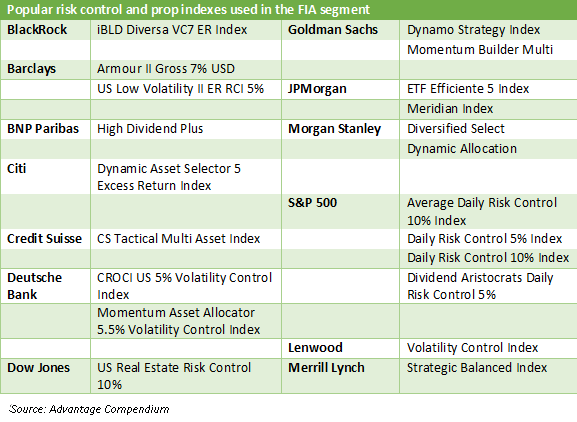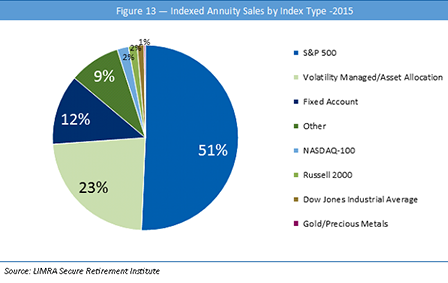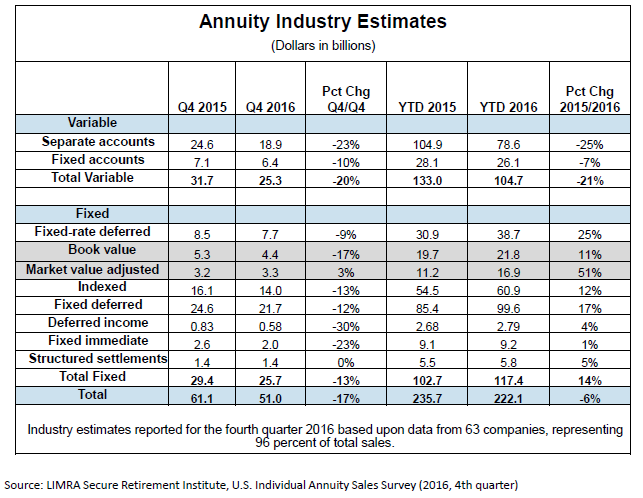Fixed-indexed annuity (FIA) sales in the US hit a record US$60.9bn in 2016, up 12% from 2015 sales of $54.5bn, according to Limra's Secure Retirement Institute Fourth Quarter US Annuity Sales survey, which was released at the end of February.
The 2016 increase in is the ninth consecutive year for FIAs despite a quarter-on-quarter decline since the Department of Labor (DoL) reclassified FIAs under the best interest contract exemption on April 2016, according to Todd Giesing (pictured), assistant research director at Limra Secure Retirement Institute. "This double-digit growth is not a new trend," said Giesing. "Over the past decade, the indexed annuities market has grown significantly. There's been a number of catalysts for this growth, most notably a distribution expansion over the last few years. The increase of distribution outlets and channels in the US market include banks, broker-dealers, and wirehouses."
The DoL fiduciary rules "have definitely" increased the focus on indexed annuity products over the past year, according to Giesing. "The reason being that, when the introduction of the rules were announced you had the variable annuity segment falling under the best interest contract exemption, while the rest of annuities went into the 84/24 exemption, but when the actual rules were introduced, fixed-index annuities were moved under the 'best interest' contract exemption, and this made them easier to handle in the current regulatory environment," said Giesing. "We have seen a slight shift in sales, which suggests that the DoL rules have had a minor impact."
Until there is some clarity on the DoL fiduciary rule, Limra expects overall annuity sales to continue to drop in 2017, according to Giesing.
The number of fee-based advisors in the advisor-managed assets market is also rising faster than other channels, according to Matt Gray, senior vice president of product innovation at Allianz Life. "The assets are also increasing at a faster pace than other distribution channels," said Gray. "Of the +/- $16.4tr in industry assets, there are already about $2.2tr covered by the RIA channel as of the end of 2015, and many of those advisors have adopted a fee-based model."
The US variable annuities market has been hit by the low interest rates environment, but structured VAs are providing a positive story for the three major insurers in the US: MetLife (distributor of Shield Level Selector), Allianz Life (Index Advantage), and Axa (Structured Capital Strategies). Other sellers include Fidelity, Voya, Lincoln Financial and Pacific Life, among others.
Also known as hybrid, index or buffer VAs, these products are also fueling activity in the index market mainly around the main US domestic cap weighted index - S&P 500 which was behind 51% of FIA sales in 2015, but also around volatility control indices which now represent around 23% of FIA sales across over three dozen volatility control indices, according to Advantage Compendium. The use of other indices, such as the Nasdaq 100, Russell 2000, MSCI EAFE Index, Bloomberg Commodity Index, Eurostoxx 50 and DJ Industrial Average was marginal.

While only 27% of 2016 vol-controlled indices were excess return based - meaning the yield of a predetermined interest benchmark is first deducted from any index gains - 58% of the new indices included an excess return calculation, according to Advantage Compendium. Prior to 2017, only 31% of vol-controlled indices had the ability to use leverage, however, 75% of the new indices may use leverage to increase exposure to high volatility when volatility is below the target level. The 12-month returns of FIA vol-controlled indices in 2016 ranged from a negative 2.95% to a positive 11.82%, according to the research company

"We expect the use of these indices will increase," said Giesing. "Their design is definitely more complex than the usual market cap point-to-point index and advisers have to explain to clients in greater detail how they work, which is why providers may offer training to advisers to help them understand these offerings."
The Limra report also unveiled that, despite the 85 basis point jump in the 10-year US Treasury interest rate, fixed immediate annuity sales fell 23% in the fourth quarter of 2016, to $2bn. In 2016, fixed immediate income annuities rose 1% to $9.2bn.
Total fixed annuity sales also hit a new high of $117.4bn, 14% above 2015 levels and nearly $7bn higher than 2009 (when sales were last at their highest). However, after strong results in the first three quarters, fixed annuity sales fell 13% to $25.7bn in the fourth quarter. "Unlike the last several years, where indexed annuities propelled overall fixed annuity growth, in 2016, fixed-rate deferred was the primary driver of fixed sales in 2016," said Giesing. "A large block of fixed-rate deferred annuities purchased in 2009 came due in the first half of the year, creating a significant amount of money in motion."

In the fourth quarter, sales of fixed-rate deferred annuities (book value and MVA) fell 9%, to $7.7bn. In 2016, fixed-rate deferred product sales were $38.7bn, up 25%. The trade body expects sales to rebound in the first quarter of 2017, responding to the post-election interest rate spike late in 2016.
Deferred income annuity sales fell 30% in the fourth quarter, to $575m, but increased by 4% to $2.8bn by the end of the year. In addition, variable annuity sales amounted to $25.3bn, down 20% in the fourth quarter: VA sales were below $30bn every quarter of 2016. Total VA sales were $104.7bn in 2016, 21% lower than 2015 and a decline of over $28bn. This is the fifth consecutive year of VA falling sales, which are nearly $80bn lower than their peak in 2007 and are at their lowest level since 1998. "Aside from the DoL fiduciary rule, one of the factors driving VA sales declines has been a drop in sales of products with guaranteed living benefit riders," said Giesing.
Total annuity sales were $51bn in the fourth quarter, a 17% fall from the previous year. This is the third consecutive quarter of decline in overall annuity sales and the lowest quarterly sales since the first quarter 2002. For the year, total annuity sales fell 6% to $222.1 billion.
Click in the links to view 2016 Annuity Industry Estimates and Annuity Sales 2007-2016. The Institute will release the top 20 annuity manufacturer rankings this month, following the last scheduled earnings release from survey participants.
Related stories:
Citi and JP Morgan prop indices deployed in new US annuity play
Allianz enters fee-based segment with fixed-index annuity, Lincoln expands fund-linked offering
Allianz links up with Wells Fargo's new indexed annuity platform